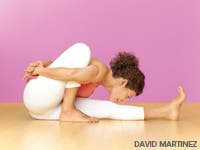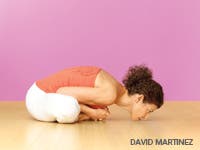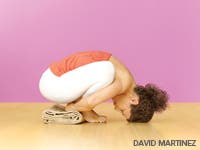Kathryn Budig Challenge Pose: Upward Rooster

This pose used to send me into a total frenzy.
I had finally figured out how to do the transition from Tripod into Crow (or Crane) Pose and was ready to expand my horizons. I knew I could get into Lotus upside down and figured it couldn’t be that much harder to transfer Lotus legs than Crow.
Au contraire my petite flying bird!
I would spend what felt like lifetimes stuck on the crown of my head trying with every ounce of my being to get my body to budge. It was horribly frustrating. But, I never stopped trying. I started noticing what wasn’t working and would check that off the list. I eventually found the delicate transfer of weight needed to get into this pose, but to this day still find it challenging.
Urdhva Kukkutasana (Upward Cock, or Rooster, Pose) is one of those poses that reminds us good things come to those who wait. If you don’t at first succeed—try, try again! You’ll get there and when you do, it will be well worth it!
Step 1:
Come into Dolphin Pose. Walk your feet in and place your knees onto your upper arms. Hug yourself into a tiny little package. Lift your hips up as your thighs draw tight into your chest. Stay compact as possible to help your center of gravity. Every few breaths, remind yourself to lift the shoulders and keep the elbows in. Once the hips stack over the shoulders, the weight of the legs will lessen and the core will connect. Hook through the lower belly to lightly pull the knees off the arms into a pike position in your chest. Keep the inner heels and big toes touching as the legs draw up toward the ceiling as if being sucked through a straw. Hug the inner thighs to the midline, expand through the backs of the knee caps, and spread the toes.
Step 2:

I covered Padmasana in Sirasana (Upside-Down Lotus), above, in my last post. Read it here!
Step 3:

Once you’ve gotten into a deep Lotus in your headstand, double check your foundation—make sure your elbows are in over the wrists and that the shoulders are lifting up to take pressure out of your neck. Start to fold your Lotus toward your body until you can rest both knees onto your arms. Once the knees land, start to walk them up the arms like a little ladder. Wiggle one leg toward the armpit, and then the next, until you can’t snuggle in any further. Reconnect to the lift in your shoulders and keep your core tight.
Step 4:

Start to press the weight of the knees into your arms as you drop the hips back and toward the ground. This will bring you into a deep fold and can feel VERY heavy (which means, take your time)! Push deeply into the heels of the hands as the fingers dig in lightly to help isometrically pull the chest forward. Once you feel a shift happening in the hips, start to roll from the crown of the head toward the hair line. When you’re eyes meet the floor, then you can start to push the ground away. Firm your upper outer arms in and round your upper back. Keep gazing forward as you elevate your pose. The round in the back will create straighter arms as you press the ground away. Keep the your Lotus as tight as you can to your torso and take 5 breaths. Either bend the elbows to come back up into headstand to release, or slide down your arms like a little fire pole and have a good laugh.
Kathryn Budig is jet-setting yoga teacher who teaches online at Yogaglo. She is the Contributing Yoga Expert for Women’s Health Magazine, Yogi-Foodie for MBG, creator of Gaiam’s Aim True Yoga DVD and is currently writing Rodale’s The Big Book of Yoga. Follow her on Twitter; Facebook; or on her website.